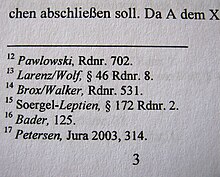footnote

A footnote is a note that the pressure - Layout from the body text to make is outsourced liquid read the text. A footnote is a "note, legend, comment, reference to source or further explanation of a text or image".
Footnote and endnote
After the relevant word , part of a sentence or a sentence to which you want to add a comment, you put a number in superscript ("comment number"). This number refers to a place introduced by the same number where the note text appears. If this point is on the same page as the text with the comment number, then one speaks of footnotes; a reference to places at the end of a chapter or the entire work is called endnotes .
According to DIN 5008 , footnotes with Arabic numerals or Roman numerals (V) must be numbered consecutively across all pages. If the entire text does not contain more than three footnotes, special characters (e.g. asterisks ) may also be used. In principle, they may only be positioned at the foot of a page and not at the end of the text. They must be separated from the preceding text by at least one blank line and the footnote (base line). It is not allowed to insert a picture below the footnote and thus at the bottom of the page. Endnotes are also not permitted according to DIN 5008, but are often also used in scientific publications, just as DIN 5008 is not binding for this type of publication. Many editors fear that footnotes could be a deterrent to a wider audience.
The totality of footnotes or endnotes of a work are called footnotes , footnotes or scientific apparatus , as opposed to the actual text of the presentation is. A footnote is only a typographical means of realizing a note and is not in itself proof of the scientific underpinning of a text.
Footnote and annotation marks in the body of the text
Duden rule
Regarding the position of the footnote reference in the running text, the Duden (Volume 1 Spelling , 24th edition 2006, section "Word processing and e-mails", pages 108/109) explains:
Nowadays, only superscript digits without brackets are common as footnotes and annotations.
If footnotes meet punctuation marks, the following basic rule applies:
- If the footnote refers to the whole sentence, the number comes after the closing punctuation mark;
- if the footnote only refers to the immediately preceding word or group of words, the number comes before the closing punctuation mark.
Scientific journals
Renowned scientific publishers such as Springer and Thieme do not place the sources in their journals as footnotes, but at the end of the article. You put the references to it in square brackets on the baseline and, if they meet a punctuation mark, always before it.
literature
- Michael Bernays : On the teaching of the citations and notes. In: On the recent and recent history of literature II. B. Behr, Berlin 1899 (= writings on criticism and history of literature by Michael Bernays. Vol. 4. From the estate, edited by Georg Witkowski), pp. 253–347 ( Textarchiv - Internet Archive ).
- Evelyn Eckstein: footnotes. Notes on poetry and science (= Notes: Contributions to scientific marginalistics. Volume 1). Lit, Münster et al. 2001, ISBN 3-8258-5112-5 (at the same time: Stuttgart, Universität, Dissertation, 1999).
- Anthony Grafton : The tragic origins of the German footnote. Dtv, Munich 1998, ISBN 3-423-30668-8 (reprint of the edition: Berlin Verlag, Berlin 1995)
- Bernhard Metz, Sabine Zubarik (ed.): Go beyond the scope. Annotation Practices in Literature, Art, and Film. Kadmos, Berlin 2012, ISBN 978-3-86599-133-1 (short description and table of contents db.romanistik.de )
- Henry J. Steffens, Mary Jane Dickerson, Wolfgang Schmale : Documentation techniques. In: Wolfgang Schmale (Hrsg.): Writing guide history. Learn scientific writing step by step (= UTB. Volume 2854). Böhlau, Wien et al. 2006, ISBN 3-205-77520-1 , pp. 273–289, here pp. 285 f. ( “What should you include in your notes / footnotes?” ).
- Anne H. Stevens, Jay Williams: The Footnote, in Theory. In: Critical Inquiry 32 (Winter 2006), pp. 208-225.
Web links
- Study on footnotes in modern novels
- Footnotes in scientific papers
- Footnotes, endnotes, electronic sources and bibliographies in a suitable format ( Memento from January 25, 2010 in the Internet Archive )
Footnotes
- ↑ Wolfgang Beinert : footnote footnote mark. Typoakademie Berlin, accessed on December 3, 2009 (article last edited on October 31, 2008).
